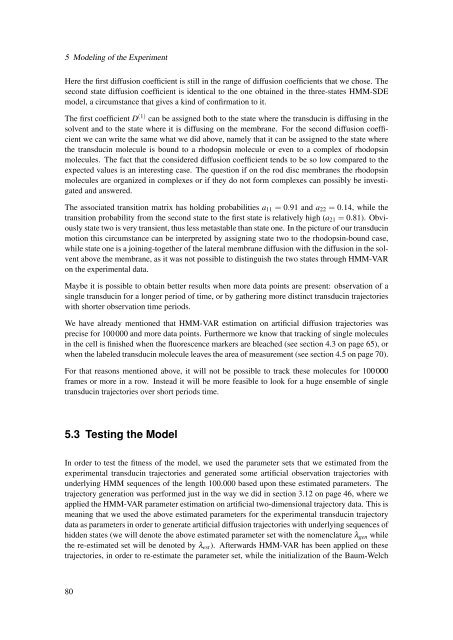Diffusion Processes with Hidden States from ... - FU Berlin, FB MI
Diffusion Processes with Hidden States from ... - FU Berlin, FB MI
Diffusion Processes with Hidden States from ... - FU Berlin, FB MI
You also want an ePaper? Increase the reach of your titles
YUMPU automatically turns print PDFs into web optimized ePapers that Google loves.
5 Modeling of the ExperimentHere the first diffusion coefficient is still in the range of diffusion coefficients that we chose. Thesecond state diffusion coefficient is identical to the one obtained in the three-states HMM-SDEmodel, a circumstance that gives a kind of confirmation to it.The first coefficient D (1) can be assigned both to the state where the transducin is diffusing in thesolvent and to the state where it is diffusing on the membrane. For the second diffusion coefficientwe can write the same what we did above, namely that it can be assigned to the state wherethe transducin molecule is bound to a rhodopsin molecule or even to a complex of rhodopsinmolecules. The fact that the considered diffusion coefficient tends to be so low compared to theexpected values is an interesting case. The question if on the rod disc membranes the rhodopsinmolecules are organized in complexes or if they do not form complexes can possibly be investigatedand answered.The associated transition matrix has holding probabilities a 11 = 0.91 and a 22 = 0.14, while thetransition probability <strong>from</strong> the second state to the first state is relatively high (a 21 = 0.81). Obviouslystate two is very transient, thus less metastable than state one. In the picture of our transducinmotion this circumstance can be interpreted by assigning state two to the rhodopsin-bound case,while state one is a joining-together of the lateral membrane diffusion <strong>with</strong> the diffusion in the solventabove the membrane, as it was not possible to distinguish the two states through HMM-VARon the experimental data.Maybe it is possible to obtain better results when more data points are present: observation of asingle transducin for a longer period of time, or by gathering more distinct transducin trajectories<strong>with</strong> shorter observation time periods.We have already mentioned that HMM-VAR estimation on artificial diffusion trajectories wasprecise for 100000 and more data points. Furthermore we know that tracking of single moleculesin the cell is finished when the fluorescence markers are bleached (see section 4.3 on page 65), orwhen the labeled transducin molecule leaves the area of measurement (see section 4.5 on page 70).For that reasons mentioned above, it will not be possible to track these molecules for 100000frames or more in a row. Instead it will be more feasible to look for a huge ensemble of singletransducin trajectories over short periods time.5.3 Testing the ModelIn order to test the fitness of the model, we used the parameter sets that we estimated <strong>from</strong> theexperimental transducin trajectories and generated some artificial observation trajectories <strong>with</strong>underlying HMM sequences of the length 100.000 based upon these estimated parameters. Thetrajectory generation was performed just in the way we did in section 3.12 on page 46, where weapplied the HMM-VAR parameter estimation on artificial two-dimensional trajectory data. This ismeaning that we used the above estimated parameters for the experimental transducin trajectorydata as parameters in order to generate artificial diffusion trajectories <strong>with</strong> underlying sequences ofhidden states (we will denote the above estimated parameter set <strong>with</strong> the nomenclature λ gen whilethe re-estimated set will be denoted by λ est ). Afterwards HMM-VAR has been applied on thesetrajectories, in order to re-estimate the parameter set, while the initialization of the Baum-Welch80









